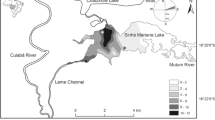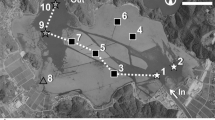Abstract
Microbial assemblages can be found drifting/floating in lake water and being washed ashore in continental Antarctica. Two field studies in early and late January 2008 measured the light utilization properties and photosynthetic responses of these assemblages, which were then compared with those of pelagic and benthic microbial communities to evaluate the ecological implications of this phenomenon. The nutrient concentrations were low in the lake water, indicating oligotrophic conditions. Based on microscopic and pigment analysis, both the floating and benthic communities were mainly composed of Oedogonium sp. (Chlorophyceae), followed by cyanobacteria, diatoms, and dinoflagellates. Floating assemblages had a firmer and denser structure, and possessed more rich carotenoids than the benthic community. Measurements of photosynthesis conducted in early January indicated that the activities of the floating assemblages were considerably low. In late January almost all floating assemblages on the lakeshore turned white because of freezing and drying by the ambient temperature decrease, and had no photosynthetic signals. These results suggest that the floating assemblages could spontaneously lift off from the lakebed because of the bubbles created by photosynthesis and then repeatedly roll, flip, sink, or float depending on buoyancy. In addition, this phenomenon seemed to greatly change the cycling of matter by transporting the lake’s photosynthetic products to the surrounding ecosystems, then give the benthic subsurface communities in dark regions a chance to reactivate such as gap regeneration in the case of climax forest, and also allow the floating assemblages to restart photosynthesis at the top of the lakebed by resinking.






Similar content being viewed by others
References
Eilers PHC, Peeters JCH (1988) A model for the relation ship between light intensity and the rate of photosynthesis in phytoplankton. Ecol Model 42:199–215
Garcia-Pichel F, Sherry ND, Castenholz RW (1992) Evidence for an ultra-violet sunscreen role of the extracellular pigment scytonemin in the terrestrial cyanobacterium Chlorogloeopsis sp. Photochem Photobiol 56:17–23
Heath CW (1988) Annual primary productivity of an Antarctic continental lake: phytoplankton and benthic algal mat production strategies. Hydrobiologia 165:77–87
Heukelem LV, Thomas CS (2001) Computer-assisted high-performance liquid chromatography method development with applications to the isolation and analysis of phytoplankton pigments. J Chromatogr A 910:31–49
Hodgson DA, Vyverman W, Verleyen E, Sabbe K, Leavitt PR, Taton A, Squier AH, Keely BJ (2004) Environmental factors influencing the pigment composition of in situ benthic microbial communities in east Antarctic lakes. Aquat Microb Ecol 37:247–263
Izaguirre I, Mataloni G, Allende L, Vinocure A (2001) Summer fluctuations of microbial planktonic communities in a eutrophic lake—Cierva Point, Antarctica. J Plankton Res 23:1095–1109
Kudoh S, Tsuchiya Y, Ayukawa E, Imura S, Kanda H (2003a) Ecological studies of aquatic moss pillars in Antarctic lakes 1. Macro structure and carbon, nitrogen and chlorophyll a contents. Polar Biosci 16:11–22
Kudoh S, Watanabe K, Imura S (2003b) Ecological studies of aquatic moss pillars in Antarctic lakes. 2: temperature and light environment at the moss habitat. Polar Biosci 16:33–42
Kudoh S, Tanabe Y, Matsuzaki M, Imura S (2009) In situ photochemical activity of the phytobenthic communities in two Antarctic lakes. Polar Biol 3:262–271
Matsumoto GI, Tani Y, Seto K, Tazawa T, Yamamuro M, Watanabe T, Nakamura T, Takemura T, Imura S, Kanda H (2010) Holocene paleolimnological changes in Lake Skallen Oike in the Syowa Station area of Antarctica inferred from organic components in a sediment core (Sk4C-2). J Paleolimnol 44:677–693
McMinn A, Hegseth EN (2004) Quantum yield and photosynthetic parameters of marine microalgae from the southern Arctic Ocean, Svalbard. J Mar Biol Assoc UK 84:865–871
Moorehead DL, Burkins MB, Doran PT, Fountain AG, Lyons WB, McKnight DM, Priscu JC, Virginia RA, Wall DH (1999) Ecological legacies: production, persistence and influence on Soil and lake ecosystems of the Antarctic Dry Valleys. Bioscience 49(12):1009–1019
Morris DP, Zagarese H, Williamson CE, Balseiro EG, Hargreaves BR, Modenutti B, Moeller R, Queimalinos C (1995) The attenuation of solar UV radiation in lakes and the role of dissolved organic carbon. Limnol Oceanogr 40:1381–1391
Pearce DA, Galand PE (2008) Microbial biodiversity and biogeography. In: Vincent WF, Laybourn-Parry J (eds) Polar lakes and rivers. Oxford University Press, Oxford, pp 213–230
Quesada A, Vincent WF (1997) Strategies of adaptation by Antarctic cyanobacteria to ultraviolet radiation. Eur J Phycol 32(4):335–342
Quesada A, Fernandez-Valiente E, Hawes I, Howard-Williams C (2008) Benthic primary production in polar lakes and rivers. In: Vincent WF, Laybourn-Parry J (eds) Polar lakes and rivers. Oxford University Press, Oxford, pp 179–196
Sabbe K, Hodgson DA, Verleyen E, Taton A, Wilmotte A, Vanhoutte K, Vyverman W (2004) Salinity, depth and the structure and composition of microbial mats in continental Antarctic lakes. Freshw Biol 49:296–319
Tanabe Y, Kudoh S (2009) Relationship between bathymetric features determined by a convenient method, and the water quality/aquatic organism of Antarctic lakes. Jpn J Limnol 70(3):191–199
Tanabe Y, Kudoh S, Imura S, Fukuchi M (2008) Phytoplankton blooms under dim and cold conditions in freshwater lakes of East Antarctica. Polar Biol 31:199–208
Tanabe Y, Ohtani S, Kasamatsu N, Fukuchi M, Kudoh S (2010) Photophysiological responses of phytobenthic communities to the strong light and UV in Antarctic shallow lakes. Polar Biol 33(1):85–100
Tanabe Y, Shitara T, Kashino Y, Hara Y, Kudoh S (2011) Utilizing the effective xanthophyll cycle for blooming of Ochromonas smithii and O. itoi (Chrysophyceae) on the snow surface. PLoS ONE 6(2):e14690
Tang EPY, Tremblay R, Vincent WF (1997) Cyanobacterial dominance of polar freshwater ecosystems: are high-latitude mat-formers adapted to low temperature? J Phycol 33:171–181
Vincent WF, Quesada A (1994) Ultraviolet radiation effects on cyanobacteria: implications for Antarctic microbial ecosystems. Antarct Res Ser 62:111–124
Vincent WF, Vincent CL (1982) Nutritional state of the plankton in Antarctic coastal lakes and the inshore Ross Sea. Polar Biol 1:159–165
Vincent WF, Rae R, Laurion I, Howard-Williams C, Priscu JC (1998) Transparency of Antarctic ice-covered lakes to solar UV radiation. Limnol Oceanogr 43:618–624
Vincent WF, Hobbie JE, Laybourn-Parry J (2008) 1 Introduction to the limnology of high-latitude lake and river ecosystems. In: Vincent WF, Laybourn-Parry J (eds) Polar lakes and rivers. Oxford University Press, Oxford, pp 1–24
Vopel K, Hawes I (2006) Photosynthetic performance of benthic microbial mats in Lake Hoare. Antarct Limnol Oceanogr 51(4):1801–1812
Wilson AT (1965) Escape of algae from frozen lakes and ponds. Ecology 46(3):376
Acknowledgments
The authors acknowledge all the members of the 49th Japanese Antarctic Research Expedition, especially its summer party leader, Dr. S. Imura, for their support. The authors also thank Ms. A. Sugimoto for assistance with nutrient analysis.
Author information
Authors and Affiliations
Corresponding author
About this article
Cite this article
Tanabe, Y., Kudoh, S. Possible ecological implications of floating microbial assemblages lifted from the lakebed on an Antarctic lake. Ecol Res 27, 359–367 (2012). https://doi.org/10.1007/s11284-011-0907-3
Received:
Accepted:
Published:
Issue Date:
DOI: https://doi.org/10.1007/s11284-011-0907-3




